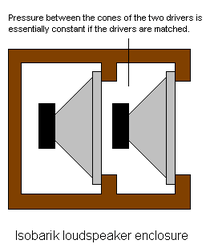Isobaric loudspeaker
The Isobaric loudspeaker configuration was first introduced by Harry F. Olson in the early 1950s, and refers to systems in which two or more identical woofers (bass drivers) operate simultaneously, with a common body of enclosed air adjoining one side of each diaphragm. In practical applications, they are most often used to improve low-end frequency response without increasing cabinet size, though at the expense of cost and weight.
The name is derived from the term Isobar ("equal pressure"), which comes from the Greek word "isobares", meaning "of equal weight".[1] As the word implies, the enclosed air does indeed experience roughly equal pressures from each diaphragm it contacts, but those forces are actually parallel, rather than opposing, so the air is forced to move.
Design principles

Two, identical, loudspeakers are coupled to work together as one unit: they are mounted one behind the other in a casing to define a chamber of air in between. The volume of this "isobaric" chamber is largely immaterial, and is usually chosen to be fairly small for reasons of convenience. In a subwoofer, where the mid-range output is not needed, the optimum arrangement is front to front. The two drivers are placed either "cone to magnet" and wired in phase with one another or "cone to cone" or "magnet to magnet" and wired out of phase with one another so that their cones move together when driven with an audio signal. The term “isobaric” points to the erroneous notion that the air pressure in the chamber between the loudspeakers is constant (the "isobaric" condition).
The two drivers operating in tandem exhibit exactly the same behavior as one loudspeaker in twice the cabinet. The cabinet is defined as the space behind the rear driver. The volume of air between the speakers has no acoustic function so that the saved space is less than 50%. All other aspects are unchanged like resonant frequency and maximum SPL. The new driver will have the same resonance frequency, Qts, distortion, excursion etc. as one driver with the same applied signal. Because the impedance is also halved, this performance is achieved with twice the power. The new efficiency is thus 3 dB lower than with one loudspeaker. The reason for the unchanged resonance frequency is simple: the new combined loudspeaker has twice the moving mass compared to the single driver but also half the compliance because of the doubled suspension.
The result is that the coupled driver pair (iso-group) can now produce the same frequency response in half the box volume that a single driver of the same type would require. For example, if a speaker is optimized for performance in a 40 liter enclosure, one iso-group of the same speakers can achieve the same low frequency extension and overall response characteristics in a 20 liter enclosure. The aforementioned volumes exclude the isobaric chamber. If the iso group is placed in the original 40 liter, the loading will be incorrect (if the 40 liter was a correct loading of the loudspeaker).
Of course if you double the moving mass of a single driver, halve its compliance and halve its impedance, you would attain identical results. Although this requires the ability to manufacture a custom driver, it has the advantage of saving space and cost because only one driver is needed.
Distortion
Any non-linear behavior of the speakers affect sound pressure within the chamber, and could give rise to distortion components. In out-of-phase designs ("cone to cone" and "magnet to magnet" designs) this tends to occur because of front-to-back non-symmetrical behavior. These may also occur when the speaker driven to high levels for an extended period of time and the voice coils of the two drivers dissipate vibration and heat at different levels because of differing air circulation (one driver is exposed to the outside air, and one is fully enclosed in a chamber). One patented design attempts to attenuate this distortion by absorptive material between the drivers.[2]
List of isobaric speakers
In production
- ADRaudio JD21
- Altec Lansing FX5051, FX4021
- Angstrom Modular Series 10" Subwoofer Ten i
- Chesky Records C1
- Linn Majik Isobarik[3]
- Linn Akubarik[4]
- McCauley Sound "M421"
- MK Sound MK 950
- Monitor Audio fastbass FB212 SUBWOOFER
- Orange Music Electronic Company Isobaric Bass Speaker Cabinet
- Neat Acoustics Momentum 3i,[5] Momentum 4i[6]
- Totem Acoustic Mani-2[7]
- Wilson Benesch Discovery Monitor and Chimera Loudspeaker.
- Peavey Peavey EU218 Isobaric Subwoofer
- Rodek RN212
- VUE Audiotechnik "as-418 Quad 18-inch Isobaric Subwoofer"[8]
Discontinued
- Linn Isobarik DMS and PMS[9]
- Linn Isobarik Sara 9[10]
- Linn Keltik[11]
- Linn Melodik Active Isobarik Bass
- Ampeg SVT50DL 'Isovent' bass cabinet
- Miller & Kreisel MX-2000
- Miller & Kreisel MX-70
- Euphonic Audio iL-110
References
- ↑ Chambers' entry for Isobar
- ↑ "United States Patent 4008374". United States Patent Office.
- ↑ http://www.linn.co.uk/all-products/loudspeakers/majik-isobarik
- ↑ http://www.linn.co.uk/all-products/loudspeakers/akubarik
- ↑ http://neat.co.uk/p_pages/momentumone.php
- ↑ http://neat.co.uk/p_pages/momentumtwo.php
- ↑ John Atkinson (2 February 1996). "Totem Acoustic Mani-2 loudspeaker", Stereophile
- ↑ http://www.vueaudio.com/products/as-418/
- ↑ "Isobarbarism". Popular Hi-Fi, February 1980
- ↑ "Product Information – Linn Products Isobarik Sara 9 Loudspeakers", Linn Products
- ↑ "Linn Keltik & Keltik Aktiv Owners Manual", Linn Products